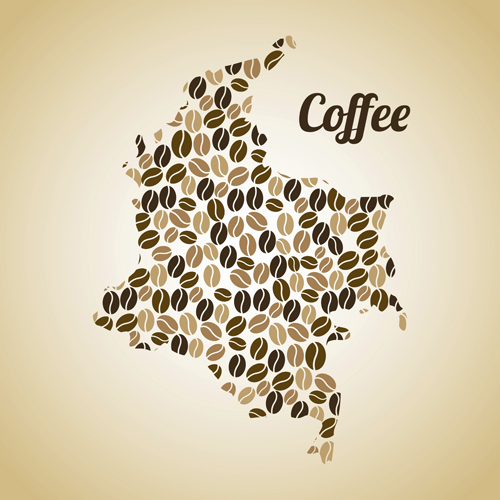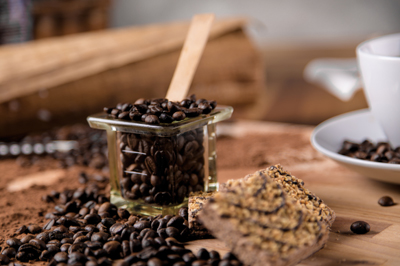03/22/2015
Submitted by Michelle on Sun, 03/22/2015 - 8:42pm
As visitors on Colombia tours to the country’s coffee regions will learn, what coffee grows where is determined by the environmental conditions that exist in the country’s three mountain ranges and the Santa Marta peak where coffee is cultivated. Certain areas of Colombia are conducive to shade-growing methods.
 Of the many Arabica coffees, mostly Typica and Bourbon heirloom varietals are grown in Colombia. Typicas, which reach about ten to fifteen feet at maturity, have a low yield but produce very flavorful coffee. Some Colombian coffee mutations are natural. These include the large-bean Maragogype, a Typica mutation from Brazil that grows taller than either the Typica or Bourbon varietals. Bourbon varieties produce more but smaller beans than the Typicas. They grow faster and are more apt to blow off the trees during harsh weather. The natural Bourbon mutation, Caturra, also from Brazil, produces a higher yield than the traditional Bourbon varietal and is more disease-resistant. It does however require fertilizer and is more labor-intensive to cultivate.
Of the many Arabica coffees, mostly Typica and Bourbon heirloom varietals are grown in Colombia. Typicas, which reach about ten to fifteen feet at maturity, have a low yield but produce very flavorful coffee. Some Colombian coffee mutations are natural. These include the large-bean Maragogype, a Typica mutation from Brazil that grows taller than either the Typica or Bourbon varietals. Bourbon varieties produce more but smaller beans than the Typicas. They grow faster and are more apt to blow off the trees during harsh weather. The natural Bourbon mutation, Caturra, also from Brazil, produces a higher yield than the traditional Bourbon varietal and is more disease-resistant. It does however require fertilizer and is more labor-intensive to cultivate.
The aroma, acidity and flavor of Arabica coffee beans make them a common ingredient in blends to improve the taste of robusta varieties. In any area of agriculture that grows a crop vulnerable to pests and disease, it is always a struggle to maintain quality when trying to produce a higher yield. Some hybrid cultivars such as Castillo and Tabi produce higher yields and are hardy, less susceptible to coffee leaf rust, but do not necessarily taste better than the heirloom varietals.
Genetically-modified cultivars are being developed in Colombia’s coffee laboratories. Purists believe that growing cultivars that combine Arabica with robusta degrade the quality of Colombian coffee. Others maintain that for the health of the industry, the increase in crop yield is worth whatever slight modification in taste coffee drinkers may experience. The debate about how to grow the industry without sacrificing quality goes on outside the purview of coffee drinkers. During travel to Colombia, visitors will have opportunities to taste a wide range of coffees.
Though most of Colombia’s best coffee is exported, visitors on Colombia tours may expect premium coffee brewed from native beans wherever their travels take them, whether in the major cities, the coffee-growing regions or elsewhere. Check out our Colombia tours that visit the regions where coffee is grown.
Coffee is not native to the Americas. Brought here by one invading country or another, coffee began to be grown in the territory that is today Colombia in the 1700s. By the 19th century, the crop had become an economic powerhouse, thanks in large part to government efforts to support the growers in regions where coffee grew best. When plummeting international coffee bean prices and civil war destabilized Colombia at the start of the 20th century, it dramatically reduced the profitability of large scale coffee plantations, giving small growers the opportunity to take over the industry.
In 2011, UNESCO named the country’s coffee cultural landscape a World Heritage Site. The area is comprised of six farming landscapes in the western and central ranges of the Cordillera de los Andes on Colombia’s west side that carry on the small-plot cultivation methods used by the growers here. The designation also recognizes the unique architecture of the eighteen communities in the foothills above the coffee fields that contain colonial-style buildings constructed with traditional materials, cob and pleated cane walls and red-clay tile roofs. These attributes make the coffee regions a popular destination on Colombia tours.
 Visitors who travel to Colombia and are accustomed to ordering their morning Starbucks brew in a vast array of combinations will find fewer options, but delicious coffee nonetheless. If your usual is an iced grande non-fat caramel macchiato melted, you’re probably out of luck. Black coffee is referred to as “un tinto.” For latte lovers, café con leche may contain more milk than they are used to. Soy and lactose-free milk are generally available.
Visitors who travel to Colombia and are accustomed to ordering their morning Starbucks brew in a vast array of combinations will find fewer options, but delicious coffee nonetheless. If your usual is an iced grande non-fat caramel macchiato melted, you’re probably out of luck. Black coffee is referred to as “un tinto.” For latte lovers, café con leche may contain more milk than they are used to. Soy and lactose-free milk are generally available.
Colombians drink their coffee with meals on work breaks called media nueves or half nines and onces (eleven), a break that may occur in the morning as its name implies or in the late afternoon modeled after afternoon tea. Brewed coffee is widely available from street vendors.
And where there is a product that people love, you can bet there is tourism, whether the object of desire is wine, chocolate or coffee. These Colombia tours offer the one-of-a-kind accommodations favored by the kind of tourists who wish to combine their love of learning with their love of the beverage. Check out our Colombia tours that include travel to the country’s coffee regions.
 Of the many Arabica coffees, mostly Typica and Bourbon heirloom varietals are grown in Colombia. Typicas, which reach about ten to fifteen feet at maturity, have a low yield but produce very flavorful coffee. Some Colombian coffee mutations are natural. These include the large-bean Maragogype, a Typica mutation from Brazil that grows taller than either the Typica or Bourbon varietals. Bourbon varieties produce more but smaller beans than the Typicas. They grow faster and are more apt to blow off the trees during harsh weather. The natural Bourbon mutation, Caturra, also from Brazil, produces a higher yield than the traditional Bourbon varietal and is more disease-resistant. It does however require fertilizer and is more labor-intensive to cultivate.
Of the many Arabica coffees, mostly Typica and Bourbon heirloom varietals are grown in Colombia. Typicas, which reach about ten to fifteen feet at maturity, have a low yield but produce very flavorful coffee. Some Colombian coffee mutations are natural. These include the large-bean Maragogype, a Typica mutation from Brazil that grows taller than either the Typica or Bourbon varietals. Bourbon varieties produce more but smaller beans than the Typicas. They grow faster and are more apt to blow off the trees during harsh weather. The natural Bourbon mutation, Caturra, also from Brazil, produces a higher yield than the traditional Bourbon varietal and is more disease-resistant. It does however require fertilizer and is more labor-intensive to cultivate.The aroma, acidity and flavor of Arabica coffee beans make them a common ingredient in blends to improve the taste of robusta varieties. In any area of agriculture that grows a crop vulnerable to pests and disease, it is always a struggle to maintain quality when trying to produce a higher yield. Some hybrid cultivars such as Castillo and Tabi produce higher yields and are hardy, less susceptible to coffee leaf rust, but do not necessarily taste better than the heirloom varietals.
Genetically-modified cultivars are being developed in Colombia’s coffee laboratories. Purists believe that growing cultivars that combine Arabica with robusta degrade the quality of Colombian coffee. Others maintain that for the health of the industry, the increase in crop yield is worth whatever slight modification in taste coffee drinkers may experience. The debate about how to grow the industry without sacrificing quality goes on outside the purview of coffee drinkers. During travel to Colombia, visitors will have opportunities to taste a wide range of coffees.
Though most of Colombia’s best coffee is exported, visitors on Colombia tours may expect premium coffee brewed from native beans wherever their travels take them, whether in the major cities, the coffee-growing regions or elsewhere. Check out our Colombia tours that visit the regions where coffee is grown.
The Coffee Traditions of Colombia
Colombia stakes its coffee reputation on three things: The Arabica beans that comprise 100% of its crop; its processing method of washing the beans, helping to give its brews a distinctively smooth taste; and the small farm ownership of its producers. As visitors on Colombia tours will realize on their arrival, coffee is not just a product here. It is a way of life.Coffee is not native to the Americas. Brought here by one invading country or another, coffee began to be grown in the territory that is today Colombia in the 1700s. By the 19th century, the crop had become an economic powerhouse, thanks in large part to government efforts to support the growers in regions where coffee grew best. When plummeting international coffee bean prices and civil war destabilized Colombia at the start of the 20th century, it dramatically reduced the profitability of large scale coffee plantations, giving small growers the opportunity to take over the industry.
In 2011, UNESCO named the country’s coffee cultural landscape a World Heritage Site. The area is comprised of six farming landscapes in the western and central ranges of the Cordillera de los Andes on Colombia’s west side that carry on the small-plot cultivation methods used by the growers here. The designation also recognizes the unique architecture of the eighteen communities in the foothills above the coffee fields that contain colonial-style buildings constructed with traditional materials, cob and pleated cane walls and red-clay tile roofs. These attributes make the coffee regions a popular destination on Colombia tours.
 Visitors who travel to Colombia and are accustomed to ordering their morning Starbucks brew in a vast array of combinations will find fewer options, but delicious coffee nonetheless. If your usual is an iced grande non-fat caramel macchiato melted, you’re probably out of luck. Black coffee is referred to as “un tinto.” For latte lovers, café con leche may contain more milk than they are used to. Soy and lactose-free milk are generally available.
Visitors who travel to Colombia and are accustomed to ordering their morning Starbucks brew in a vast array of combinations will find fewer options, but delicious coffee nonetheless. If your usual is an iced grande non-fat caramel macchiato melted, you’re probably out of luck. Black coffee is referred to as “un tinto.” For latte lovers, café con leche may contain more milk than they are used to. Soy and lactose-free milk are generally available.Colombians drink their coffee with meals on work breaks called media nueves or half nines and onces (eleven), a break that may occur in the morning as its name implies or in the late afternoon modeled after afternoon tea. Brewed coffee is widely available from street vendors.
And where there is a product that people love, you can bet there is tourism, whether the object of desire is wine, chocolate or coffee. These Colombia tours offer the one-of-a-kind accommodations favored by the kind of tourists who wish to combine their love of learning with their love of the beverage. Check out our Colombia tours that include travel to the country’s coffee regions.














